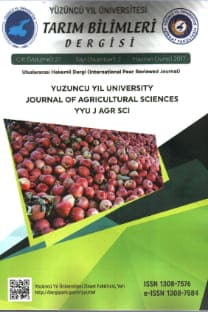Kadmiyum, Kurşun ve Çinko ile Kirlenmiş Toprağın Brassica Napus ile Fitoksraksiyonuna EDDS Uygulamasının Etkisi
Effects of EDDS application on phytoextraction of cadmium, lead and zinc contaminated soil with Brassica napus
___
- Angelova VR, Akova VI, Krustev SV, Ivanov KI (2015). Potential of safflower (Carthamus tinctorius L.) for phytoremedation of soils contaminated with heavy metals. World Academy of Science, Engineering and Technology, International Science Index 102, International Journal of Agricultural and Biosystems Engineering, 9(6), 607 - 614. http://waset.org/publications/10001509
- Attinti R, Barrett KR, Datta R, Sarkar D (2017). Ethylenediaminedisuccinic acid (EDDS) enhances phytoextraction of lead by vetiver grass from contaminated residential soils in a panel study in the field. Environ. Pollut. 225: 524-533.
- Baker AJM (1981). Accumulators and excluders-strategies in the response of plants to heavy metals. J. Plant Nutr. 3: 643-654. DOI: 10.1080/01904168109362867.
- Bouyoucos GJ (1962). Hydrometer method improved for making particle size analysis of soils. Agron J. 54: 464- 465.
- Çiftçi A (2016). Çoklu Metal (kadmiyum, kurşun ve çinko) ile Kirlenmiş Bir Toprağın Arıtımında Yabani Hint Yağı (Ricinus communis) ve Aspir (Carthamus tinctorius) Bitkilerinin Fitoremediasyon Kapasitesinin Araştırılması Mersin Üniversitesi Fen Bilimleri Enstitüsü Yüksek Lisans Tezi (Multimetal (Cadmium, Lead and Zinc) Treatment of Soil Contaminated with a Wild İndian Oil (Ricinus comminus) and Safflower (Carthamus tinctorius) Investigation of Phytoremediation Plant Capacity), Master Thesis, Graduate School of Natural and Applied Sciences, University of Mersin (in Turkish).
- Dağhan H (2007). Fitoremediasyon: Bitki Kullanılarak Kirlenmiş Toprakların Temizlenmesi (Phytoremediation: using plant to clean up contaminated sites). GAP V. Tarım Kongresi, Bildiriler Kitabı, s.362-367, 17- 19 Ekim 2007, Şanlıurfa, Türkiye (in Turkish).
- Dağhan H (2011). Doğal Kaynaklarda Ağır Metal Kirliliğinin İnsan Sağlığı Üzerine Etkileri (The effects of heavy metal contaminations in natural sources on human health). MKU Ziraat Fakültesi Dergisi (Journal of Agricultural Faculty, MKU) 16 (2):15-25 (in Turkish).
- Evangelou MWH, Ebel M, Schaeffer A (2007). Chelate assisted phytoextraction of heavy metals from soil. Effect, mechanism, toxicity, and fate of chelating agents. Chemosphere 68: 989-1003.
- Grčman, H, Vodnik D, Velinkonja-Bolta Š, Leštan D (2003). Ethylenediamine dissuccinate as a new chelate for environmentally safe enhanced lead phytoextraction. J. Environ. Qual. 32:500–506.
- Kasiuliene A, Paulauskas V, Kumpiene J (2016). Influence of nitrogen fertilizer on Cd and Zn accumulation in rapeseed (Brassica napus L.) biomass. Agron. Research 14(2): 418–427.
- Kos B, Grčman H, Leštan D (2003). Phytoextraction of lead, zinc and cadmium from soil by selected plants. Plant Soil Environ. 49(12): 548-553.
- Lee J, Sung·K (2015). EDDS effects on heavy metal uptake by bioenergy plants. J. Soil Groundw. Environ. 20(4): 8-14.
- Lindsay WL, Norvell WA (1978). Development of a DTPA test for zinc, iron, manganese, and copper. Soil Sci. Soc. Am. J. 42: 421-428.
- Luo C, Shen Z, Li X (2005). Enhanced phytoextraction of Cu, Pb, Zn and Cd with EDTA and EDDS. Chemosphere 59:1-11.
- Markwell J, Osterman JC, Mitchell JL (1995). Calibration of the Minolta SPAD-502 leaf chlorophyll meter. Photosyn. Res. 46(3): 467-472.
- Singh J, Kalamdhad AS (2011). Effects of heavy metals on soil, plants, human health and aquatic life. Int. J. Res. Chem. Environ. 1 (2):15-21.
- Soil Survey Staff (1951) Soil Survey Manual. U. S. Dept. Agr. Handbook No:18, U.S Goverment Print Office, Washington
- Sumiahadi A, Acar R (2018). A review of phytoremediation technology: heavy metals uptake by plants. IOP Conf. Ser.: Earth Environ. Sci. 142 012023: 1-9.
- Takahashi R, Yamayoshi K, Fujimoto N, Suzuki M (1999). Production of (S,S)-Ethylenediamine-N,N'- disuccinic Acid from Ethylenediamine and Fumaric Acid by Bacteria. Biosci Biotechnol Biochem.;63(7):1269-73. DOI: 10.1271/bbb.63.1269
- Tangahu BV, Abdullah SRS, Basri H, Idris M, Anuar N, Mukhlisin M (2011). A review on heavy metals (As, Pb, and Hg) uptake by plants through phytoremediation. Int. J. Chem. Eng. Volume 2011, Article ID 939161, 31 pages, DOI: 10.1155/2011/939161.
- USEPA (1995) Method 3051, Microwave assisted acid digestion of sediments, sludges, soils and oils. In: Test Methods for Evaluating Solid Waste, 3rd ed, U.S. Environmental Protection Agency, Washington DC.
- Ullah S, Shahid M, Zia-ur-Rehman M,Sabir M (2014). Phytoremediation of Pb- contaminated soils using synthetic chelates. in Chapter 14, Hakeem K, Sabir M, Ozturk M & Mermut AR (Eds.). Soil remediation and plants: prospects and challenges. Academic Press.
- Ullmann A, Brauner N, Vazana S, Katz Z, Goikhman R, Seemann B, Marom H, Gozin M (2013). New biodegradable organic-soluble chelating agents for simultaneous removal of heavy metals and organic pollutants from contaminated media. J.Hazard. Mater. 260: 676-88. DOI: 10.1016/j.jhazmat.2013.06.027
- Wuana RA, Okieimen FE (2011). Heavy metals in contaminated soils: A review of sources, chemistry, risks and best available strategies for remediation. ISRN Ecology, Volume 2011, Article ID 402647, 20 pages, DOI: 10.5402/2011/402647
- ISSN: 1308-7576
- Yayın Aralığı: 4
- Başlangıç: 1991
- Yayıncı: Yüzüncü Yıl Üniversitesi Ziraat Fakültesi
Necat TOĞAY, Yeşim TOĞAY, Füsun GÜLSER
Rumaisha ISHTIAQ, Sadam MUNAWAR, Muhammad Nisar ANJUM, Faiz Ahmad JOYIA, Ghulam MUSTAFA, Muhammad Amjad ALI, Muhammad Sarwar KHAN
The Effects of Rootstock Cutting Thickness on Final Take, Quality of Potted Grapevine Saplings
Şevket Metin KARA, Muhammed Akif AÇIKGÖZ
Nalân Nazan KALKAN, Nurhan KESKIN
Rahim GHARESHEIKHBAYAT, Eissa ZARIFI
Gamze SANER, Sule AZAK, Yaşar Tevfik TUZUN
Fisun Gürsel ÇELİKEL, Sevim DEMİR
Farklı Yöntemlerle Islah Edilen Meraların Bitki ve Toprak Özellikleri
Altıngül Özaslan PARLAK, Ahmet GÖKKUŞ, Nuray Mücellâ MÜFTÜOĞLU, Cafer TÜRKMEN
Dietary Enrichment of Eggs with DHA Using Different Sources of Fatty Acids
